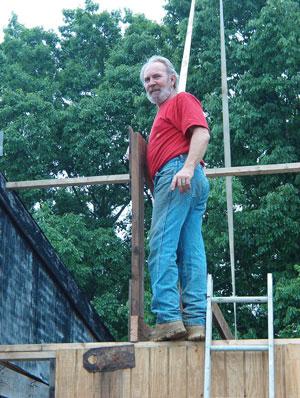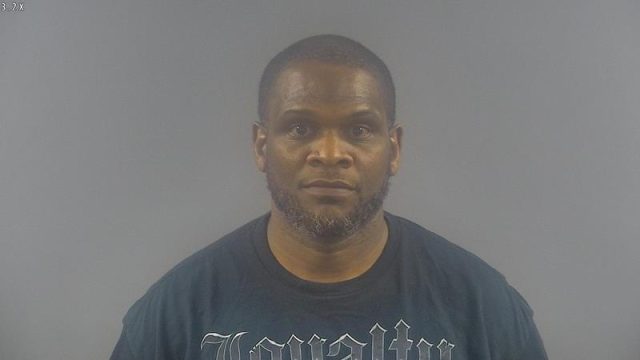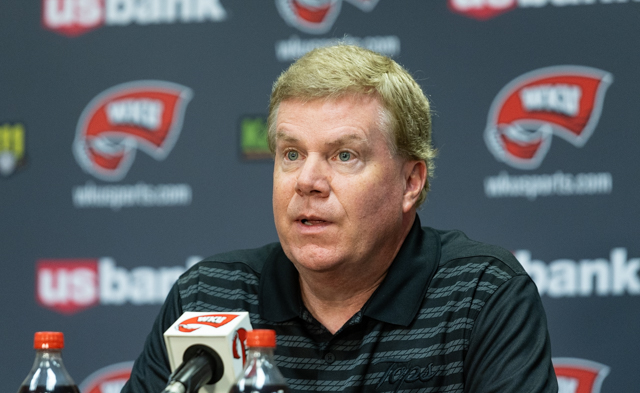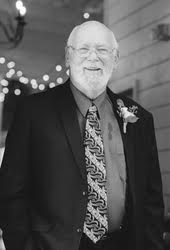Donnie Firkins: Forging new ground
Published 12:00 am Friday, September 28, 2007

- Donnie Firkins: Forging new ground
When opportunity beckons, Donnie Firkins emerges from his wooded retreat to serve as an activist for visual artists and a catalyst for immortalizing local legends like Sam Bush, Duncan Hines, Ernest Hogan and the area men and women that have served our country.
Firkins most recent endeavors like the new organization ArtWorks: A Visual Arts Coalition and plans to create bronze statutes commemorating local pioneers are part of his efforts to gain acknowledgement and respect for artists. He believes that the public is largely unaware of the work involved in doing art and how important it is to financially enable artists to continue with their work. The process involved in many of the arts which Donnie practices are extremely labor intensive. (Visit amplifier.bgdailynews.com for a video on the process of Lost Wax Casting).
Trending
Firkins comes by his love of the work he does honestly. He says “I found out afterwards, but am pleased to know where a love of the craft I do comes from. They are part of my bloodline”. Through his genealogy studies Donnie discovered in 1792 his ancestors were wagon builders and blacksmiths that settled in Kentucky.
His first experiences with artistry came by helping his grandfather in his work caning chairs. “We would take what he would call a slide (sled) and hook the mule up. It had strips of tree bark. He scaled the tree and soaked the strips in the spring. We would bring them up and put them in a drum of water and do chair bottoms. He was also a carpenter, just worked with his hands.”
Born in 1947 in Metcalfe County, the Firkins lived simply. “I was born in a log house with no plumbing or electricity. I love to be in the trees, they were the first thing I saw. I’m safe there. I require land.” said Firkins.
Donnie lived this idyllic life in the woods with his grandfather until he became of age to attend school. “I was a little wild child in the woods. At seven he brought me to town to go to school and I hated it. I think I’ve been trying to get back ever since.”
He lives as closely to that as he can in his refuge off of Scottsville Road. The 34 acre gentleman’s farm includes a pre-civil war log cabin which Firkins moved from Butler County. The cabin is the Moses Helm house built by the ancestors of local car dealer Jim Johnson. The cabin was moved in pieces and reassembled and then additions were built on by Donnie and his friends.
Other buildings are also created of logs and were relocated from Allen, Barren and Warren county locations. They currently serve as a foundry, modeling studios, and a terra cotta workshop. He has recently started construction on a blacksmith shop. A small structure near his stream which he refers to as the Creek House Studio is a refuge for quiet and meditation when in the conceptual stage of a new project. “I need a house that has some character and history” Donnie explains. He takes great pleasure in researching the history of the cabins he purchases.
Trending
Firkins eventually adjusted to school life, particularly when art instruction was introduced. His first sculpture was in the seventh grade of a girl named Peggy Whitty whom he admired. He also enjoyed painting and other projects he was assigned. In third grade his talent was acknowledged with an award for drawing. By middle school he had joined the Art Club and like many other Barren County students drew inspiration from teacher Karl Weis. “He had influence on many people. I may model him one day. He was so instrumental in so many lives. When he died last year you couldn’t get into the funeral home there were so many people. He was a cool guy whose last request included playing Happy Trails at the funeral service.”
After school Firkins attended Western Kentucky University as an art major specializing in painting and flat wall pieces. In 1975 he graduated with a Bachelor of Fine Arts and worked full time for the Goad Sign Company, eventually buying part of the business. Art took a back stage as the business grew quickly and consumed him. By 1986 he was ready to sell the business and get back to art. He discovered that it was sculpture that particularly interested him. One of his earliest pieces called The Flame can be seen in the US Bank Lobby downtown. It was made from welded steel. Though he enjoyed welding and hammering metal pieces and experimenting with texture and color he soon learned the economics of metalwork. The equipment and raw materials involved came at a high cost and most of the money earned by the sale of his business was reinvested in equipment.
Donnie was soon invited to exhibit work at area shows like Brecia College in Owensboro and the Carnegie Art Center in Covington. Each exhibit resulted in more sales of his work.
During this period he discovered stone work. “I love stone. I think the first thing that I realized liking was that I was taking something raw from the earth that most would neglect or disregard and turning it into a piece of living art that people would purchase. The other side was the shear power of being able to manipulate something like a rock into a piece of art. It’s an ego, power thing.”
His next fascination was with casting. After becoming a consultant for the Kentucky Arts Council, he began attending workshops like the “What Is Art?” presentation in Indiana in 1989. There he met a sculptor named David Kocka. Firkins and Kocka shared a ride and Kocka showed Firkins the beginnings of his foundry. The two became close friends and built the foundry together. Donnie commuted to Indiana to work with Kocka for about eight years. Kocka taught Firkins to cast or mold liquid metals. They also collaborated on one piece for the public library, for which Firkins taught Kocka to carve stone. The piece is mounted on bearings and interacts and rotates by wind movement. .But by 1982 the travel became too difficult and Firkins purchased his current home to begin his own foundry.
“From that point on I’ve been modeling, casting , selling and producing pieces. I forget how many collectors I have but generally when I do a piece it’s already sold or close to it. They know I’m working on something and get interested and curious. I invite them to watch me work and they get the right feel for home. I’m. pretty active in community. plus I’m doing exhibits. I talk to people and invite them to watch. They understand the concept and start getting fascinated and want to own something.”
Firkins was approached by Warren County officials to work with the local Veterans Liaison Board in creating a tribute to the armed services. Warren County Fiscal Court appropriated money and Firkins worked closely with representative of the veterans to bring their concept to life.
“They wanted to represent, past, present and future wars. They wanted to represent those areas of the sacrifice in a way that will continue to live on for future. They wanted to cover four branches; Army, Navy, Marines, and Airforce.” After hearing their thoughts Firkins would find models to dress up and pose and return to the board with photographs that he thought. fit the image of what they wanted. “When you’re working with a group like that they have the idea in their brains but can’t express it. But when I take a photograph they say ‘yeah that’s what I mean’”.
While Firkins generally purchases the bases for his statuary he made the base for the veteran’s piece. The concrete underneath was covered by native warren county brick he collected through the years. They. matched the ones on the courthouse which he surmises were also made at the local brickyard where Brickyard Café now stands. The stone on the top rim was quarried from White Stone Quarry here in Bowling Green. Though it closed years ago Firkins is granted entry for work material. Of it’s 1920-30s heyday, Firkins says “It was famous back then. Lots of buildings around the country were built from that stone.”
Some of the veterans visited while he was modeling and Judge Mike Buchanon came to see the process. “He was surprised how long it takes. I can’t make it go any faster no matter how much help I have. People that hear bronze are use to hearing the word and seeing those little shoes. They are not like what I do.”
During the modeling process the veterans wanted the sailor pose to be stiffer. They wanted more regimented feelings to better convey what they were trying to tell. Donnie had to stand back and accept the fact that they wanted to change his work and then try to alter it to get across their concepts “Doing what they want eats up time. Many artists won’t allow it. But this was for a lot of people and it’s tough to make everyone happy. I’m sure some don’t like it now. I like people to see what I’m doing because a lot of expense is in it after that. Modeling is the cheapest part except for the labor.” While most artists take offense to input about their work in the creation stages Donnie says “Reproducing humans is not as locked in. I want it to be pleasing unless they are extreme. I never take commissions for my abstract work though as that is really robbing me of creativity”
The entire veteran’s project took twenty months from concept to completion and installation: Four months of mold making, eight of casting and two for the base and mounting. The size of working pieces is limited by being able to hold and roll them in a 36 inch tank, so they are made in parts and welded together.
Firkins transported the clay models downtown for the 4th of July so the public could see the images. This is also normally unheard of and resulted in the need for lots of repair. When the job was complete the Governor and other dignitaries came for the unveiling. Many veterans and politicians took the stage for the ceremony. However Donnie Firkins was not invited to join them nor was his name mentioned during the presentation. “It was about the veterans not about me” he says. Though his wounds are more apparent with regard to the plaque that acknowledges the artist last rather than first which would be more standard.
Similar experiences among artists have sparked concerns about the way the local community views artists. Many local artists were inspired to action when the local Chamber of Commerce announced it was seeking donated artwork that matched the décor installed by paid contractors. Donnie also wants artists to learn to be involved in the community, keeping up with City Commission meetings and projects for public spaces that could include art. Most committees for local beautification do not include artists, however recently artist Alice Gatewood Waddell was appointed to the Downtown Redevelopment Board.
Donnie began talking with people and asking advice on how to facilitate change. He also began talking to local politicians about funding for public art. Eventually his efforts gave birth to a recently founded organization called ArtWorks: A Visual Arts Coalition. (http://www.weepingwillowstainedglass.com/artworks) The group has about 45 members, several of which are very active. They recently adopted a mission statement: “ArtWorks: a Visual Arts Coalition is a non-profit organization of artists, patrons, and supporters dedicated to creating a sustainable art community by increasing visibility, vitality, and economic growth for the visual arts.”
During his work at the Kentucky Arts Council Firkins estimates that 80% of funding went to performing arts. Therefore he believes “The visual artists need to have their own entity. I am not working for an arts general fund. If performing and visual arts are together the draw for politicians is to performing”. Artists are commonly called upon to donate work for various causes. Firkins estimates his donations over the past few years total $100,000. “We want those groups to help this group now.” he adds.
“The reason that I’m doing this is that I want to see the respect of the visual artists in this area changed and also have people understand that we have to make a living too. I especially have a large overhead. I have to have cash flow just like any of the other businesses that are in this town. For us to ever have the quality of work that we want the city to have we have to get organized and get proper legal, nonprofit establishment for bringing in funds and then give grants back to members to produce pieces. I want the public to see the importance of purchasing art. The money from purchased works will have a percentage going to the artists and some going to group. We will act as an arts council keeping funds available for the group and individual artists.”
Firkins recently completed another project for Warren County Fiscal court. He was subcontracted by Monty Brown of MGB Construction who was charged with restoration on the courthouse funded by a Historic Preservation grant. Atop the 16 columns of the bell tower the wrought iron capitols placed in 1867 were rusted. Firkins was hired to repair 544 scrolls, leaves and brackets that made up the capitols, 80% of which needed to be recast from scratch.
With the restoration complete now Donnie Firkins has turned his attention to a future project he feels very strongly about. Plans are to begin a foundation and find a home for bronze likenesses of Bowling Green groundbreakers. He hopes that the statutes can be placed on Circus Square or one of the other green spaces being created. But he is not waiting to find their final resting place. His research has already begun studying the lives of his first chosen subjects. Donnie has 100 pictures of Sam Bush and has already taken preliminary measurements of him. He is watching video of his performances, looking for the movements that express his personality. He is also reading about Ervin Houchens. “Mr. Houchen’s nickname was Tut. I want to understand what his feelings were, who he was, what he was about and how he saw life. The little nuances that I pick up I can take and turn into the character. I deal with the family and listen to their stories for these clues.”
He plans statues of: Sam Bush, Ervin Houchens, Duncan Hines, Ernest Hogan, Judge Reynolds and Dr. Jones. He is also considering John Carpenter who he was not previously familiar with as well as Charlie Garvin.
“I think it’s important that we know the people that made this city, the men and women that made what we live everyday and be able to share the heritage of the city with the people that don’t know about how it came to be. I am fascinated by these people.”
Donnie Firkins also gives back to the community by restoring trains for the Friends of the L&N Depot as a volunteer. “I do whatever I can do to bring back the flavor of the old railroad station.” Firkins worked on the Railroad Post Office car and is helping restore the 1922 original car that came through. up to WWII. They are rebuilding it inside and out. He is part of an all volunteer group. “I am excited to be part of it, bringing back the history of the city.”
And Firkins also continues to inspire his own group of volunteers, collecting apprentices fascinated with the process of his work. Local fire fighter Tim Cornett discovered Donnie on the studio tour that takes place each November and spends much of his spare time assisting Donnie in his work and learning his techniques. Dr. Hugh Sims and local screen printer Brian Bostic are also among Firkins most valuable assistants who are learning to cast and carve stone.






